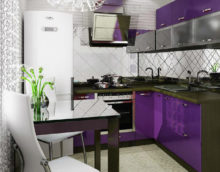What is the freshness zone in the refrigerator: types, disadvantages and advantages, tips.
Fans of healthy eating are less and less trusting the modern food industry, preferring to use classic fresh products. The question of maximum long-term storage, without loss of nutritional and taste qualities, comes to the fore. Traditional refrigerators and freezers cannot provide this, but modern technologies come to the rescue. Let's try to figure out what the freshness zone in the refrigerator is for, and how to use it correctly.
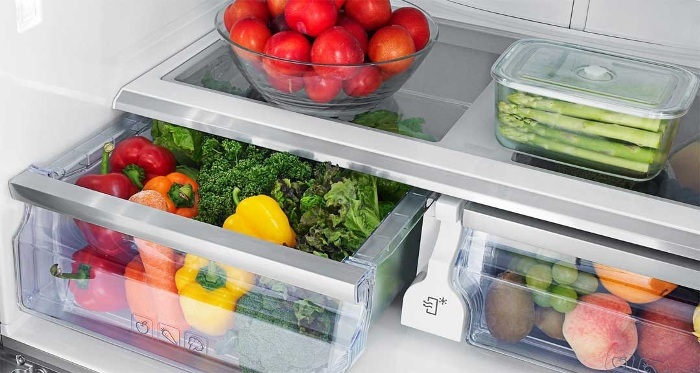
Many people wonder how to store the freshness of fruits; for this, a freshness zone was invented in the refrigerator.
Content
Who and when came up with the freshness zone
At the end of the last century, nutritionists found that the best temperature for storing food, which was the goal to maintain, was a range from 0 to +1 degrees Celsius. This is the middle ground between the expiration date and the preservation of useful properties. The structure of the product is not destroyed by ice crystals, in contrast to freezing. Microorganisms develop much more slowly, leading to spoilage - as at the usual temperature of + 5-8 degrees for cold rooms.

In 1996, Liebherr created a freshness zone in refrigerators.
Liebherr engineers were the first to introduce an innovative technology called Biofresh in 1996. The novelty was positioned as an ideal solution for people who care about their health. After success in the market, other manufacturers also began to develop and offer their solutions. To date, in the line of every famous brand there are models of refrigerators with a fresh zone.
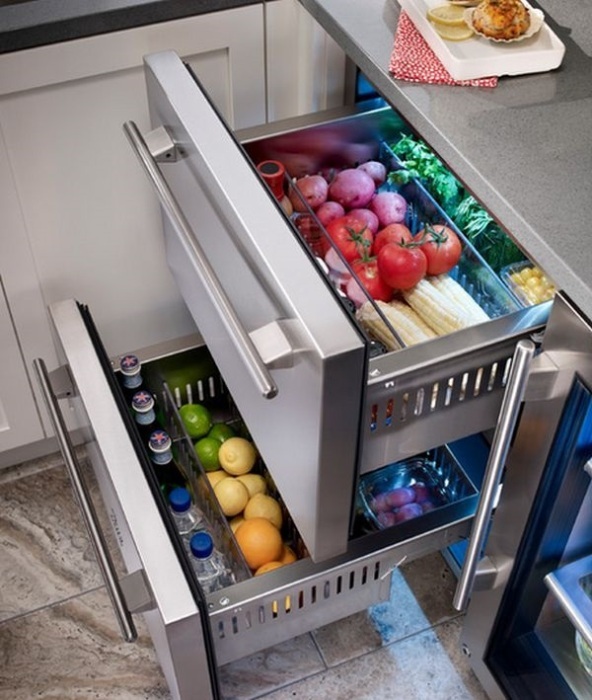
Every modern refrigerator has a fresh zone.
Features of the freshness zone
Depending on the brand and model of the refrigerator, the zero zone in it may have the following distinctive characteristics:
- Ultrafast cooling - the function will be useful for sensitive products that change their gastronomic qualities literally during the day. For example, freshly picked raspberries.
- Air ionization and antibacterial wall coating positively affect the freshness of products. The likelihood of developing pathogenic bacteria at near-zero temperature is already small, but additional safety net will not be superfluous.
- Duration of autonomous temperature support during power outages. Some models are able to keep the desired temperature level for up to a day, provided that the camera door does not open.
- Some models have automatic power consumption control. Special sensors detect when there is nothing in the drawers of the camera, and during this time the compartment becomes an ordinary refrigerating chamber, consuming less energy.
Of great importance is the presence of its own cooling system, independent of the rest of the cameras. This significantly increases the efficiency and reliability of the entire refrigerator.
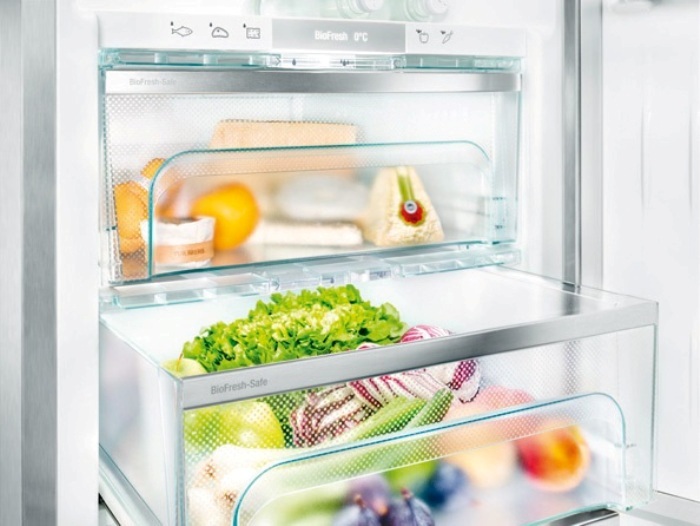
In refrigerators of different models, the zero zone may differ.
Disadvantages and advantages
The negative aspects of having a freshness compartment are subjective or individual.Their presence increases the cost of the refrigerator and potential repairs, and also increases energy consumption. Many people acquire equipment and do not think whether they really need the proposed fashion options. In large families, perishable foods do not last long. As in the kitchens of active people, who for the most part eat semi-finished products that do not require special storage conditions. For these consumer groups, the fresh zone will be a waste of money.
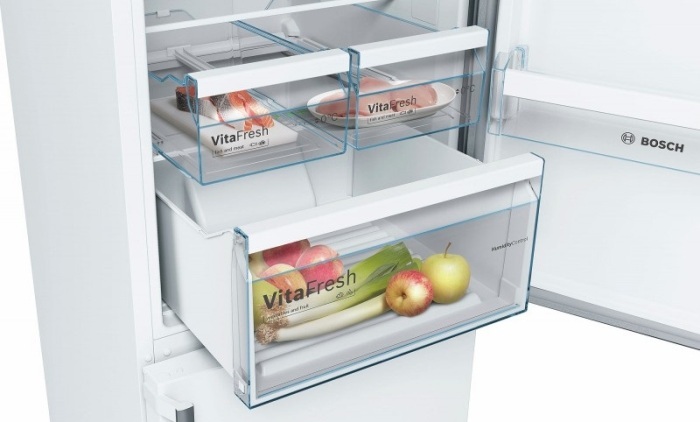
The biggest disadvantage of the zero zone is the high price.
In some models of refrigerators, it is possible to store only a specific type of product, most often vegetables and fruits. Meat delicacies will deteriorate even faster than in a classic refrigerator. This is due to the characteristics of humidification. But this fact can be attributed to the minuses only conditionally - the presence of specialized compartments depends on the status of the model.
The main advantage is the ability to store products for a relatively long period, while not destroying their structure by freezing. In some cases, it can serve as an energy-saving alternative to the freezer.
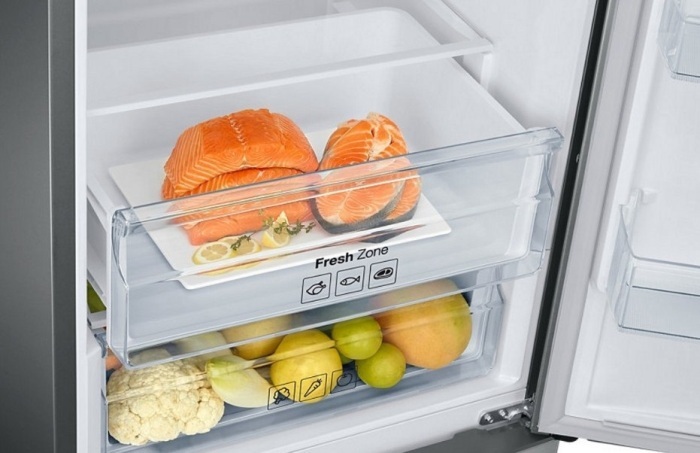
Thanks to the fresh zone, products can be stored for quite some time, without freezing them.
The purpose of the freshness zone
The zone of freshness managed to become a sacred cow for supporters of a rational diet. Zero temperature allows you to keep greens, vegetables, fruits, berries and many other products fresh for a longer period than can be done in the main chamber. At the same time, all important vitamins and other trace elements remain intact. The storage period of milk significantly increases - low temperature slows down the development of lactic acid bacteria.
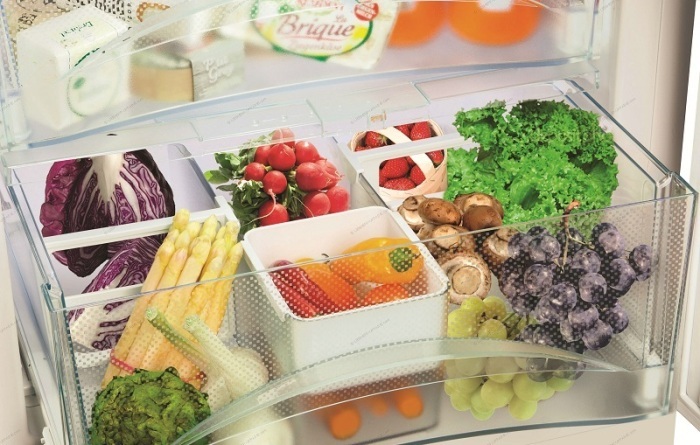
In addition to vegetables and fruits, in the zero zone you can also store the freshness of milk.
Even if a person is not concerned about a healthy diet, such a compartment can be useful. When cooking meat dishes, often there are excess minced meat or meat that must be frozen again. Not only protein compounds and useful substances of meat suffer from such procedures, but taste also changes, not for the better. The presence of fresh zones will allow you to save the leftovers for at least a week - this is quite enough until the next meal preparation.
Some types of vegetables and seafood after freezing almost completely lose their taste and nutritional qualities, therefore they can only be stored in a refrigerated form. If there are such products in the diet, the zero zone becomes an everyday necessity.
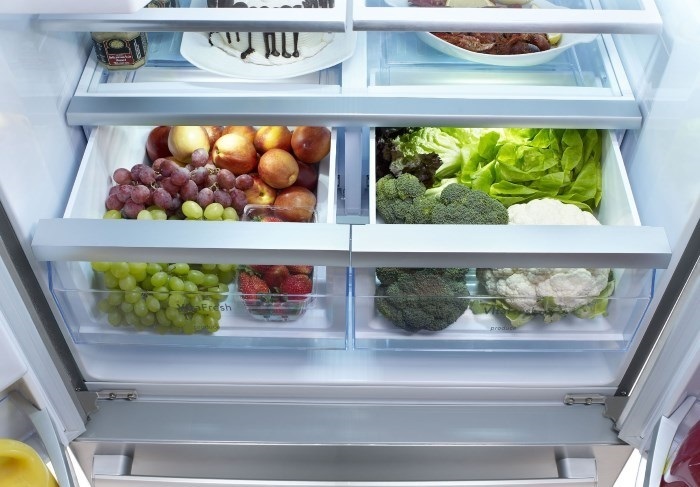
The zero zone allows you to store fruits and vegetables without loss of vitamins and minerals.
Which models have a fresh zone?
In the lineup of each major brand there are models with a freshness zone. Such devices are, as a rule, in the middle and high price categories. Below are several models that are popular in the domestic market, prices are as of March 2019:
- LG GR N309LLA - one of the best embedded solutions in terms of price / quality. The world famous Korean manufacturer has equipped the refrigerator not only with a sufficiently large zero zone, but also with options for super-cooling, maintaining the cold, an ice generator and many other useful functions. There is also a three-section freezer. The cost is about 48,000 p.
- Liebherr CBN 4815-20 - an offer from the pioneer of refrigerators with a freshness preservation zone, the volume of which here is 94 liters in two compartments. The user can independently adjust the temperature and humidity in it at his discretion. Food boxes are equipped with telescopic rails. Will cost 67,000 p.
- Beko CN 327120 is a real hit from a Turkish company (for the Russian market, production is localized at a plant in the Vladimir region), with a price tag from 12 to 17 thousand rubles, depending on the store.For this money, the buyer receives No Frost modes in both the refrigerator and freezer compartments, and decent functionality.
- Samsung RB 37 J 5200 is another representative of South Korea. It has an impressive volume of cameras and a special fresh zone, positioned as a compartment for storing milk drinks. All information on the operation of technical components is displayed on an external display. Cost - 43,000 p.
- Sharp SJ-XE55PMBK - a stylish model originally from Japan, comes to Russia from production in Thailand. The 45-liter zero compartment is equipped with an automatic energy-saving mode and is capable of supporting autonomous operation without connecting to a network for 19 hours. Very low noise. The average price tag is 58,000 p.
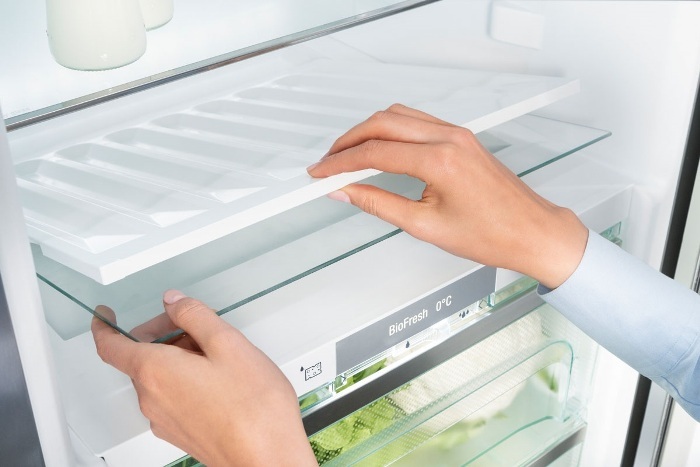
To date, many foreign brands offer refrigerators with a zero zone.
Biryusa, the Russian manufacturer of refrigeration equipment from Krasnoyarsk, is not far behind. The model range of the Full no Frost series is equipped with fresh food storage areas with multithreaded air supply, which allows you to bring the temperature of the products placed in the refrigerator to the required level in the shortest time. Prices are quite affordable - in the range of 16000-23000 p.
Where is the freshness area
In most cases, the fresh zone is a dedicated compartment with drawers that are equipped with thermal insulation. Buyers often ask themselves what the zero chamber in the refrigerator is - a compartment for preserving freshness, physically isolated from the other two chambers (refrigerator and freezer). It has its own cooling system and door. This allows you to most effectively withstand the temperature regime, which is inevitably violated in the immediate vicinity of the often open main camera.
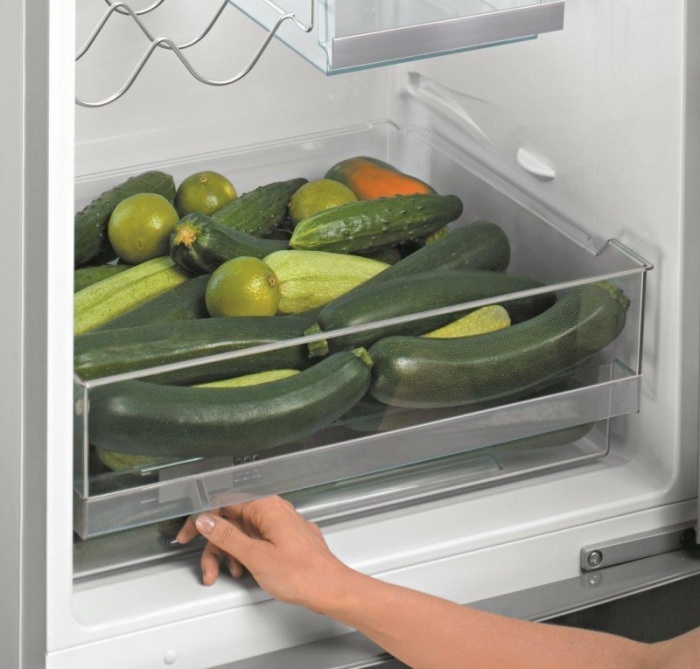
The zero zone is separated from other chambers and equipped with its own door.
The location depends on the design features of the model. In standard two-chamber refrigerators - in the main chamber, closer to the freezer. In a three-chamber design - in the middle, between the refrigerator and freezer compartments. The department itself can be divided into several parts for its intended purpose - there are sections specifically for meat, vegetables or milk drinks. Some brands have models with the ability to change the purpose of the cameras, you can make at least the entire refrigerator a zero zone. The price of such devices is appropriate.

In some refrigerators, the zero zone is divided.
How does the freshness zone work?
The principle of operation depends on the price segment and manufacturer.
- In budget-class models, cooling occurs in a passive way - from contact with the freezer wall and sealing (partial or full), to minimize heating from the main chamber. This is not the most effective way, the temperature of the sectional departments is characterized by a high error. But this allows you to significantly reduce the cost, and hence the final retail price of the goods.
- In the middle price class, a semi-active system - through a special hose from the freezer, cooled air enters until the thermostat stops the flow. A plus can be called high efficiency, but since the cooling element does not flow evenly, products located close to the duct can freeze. The location of the contents of the camera must be monitored, and this is inconvenient. Specialists of the Russian Biryusa implemented a multi-threaded air supply system in their equipment, partially solving the problem.
- In the premium segment, the cooling system of the freshness zone is completely autonomous, equipped with auxiliary sensors and humidity control in the chamber. For continuous circulation of cold air, low-noise ventilation devices are built in. Sophisticated units significantly increase the cost of the refrigerator, but it pays off for better performance.
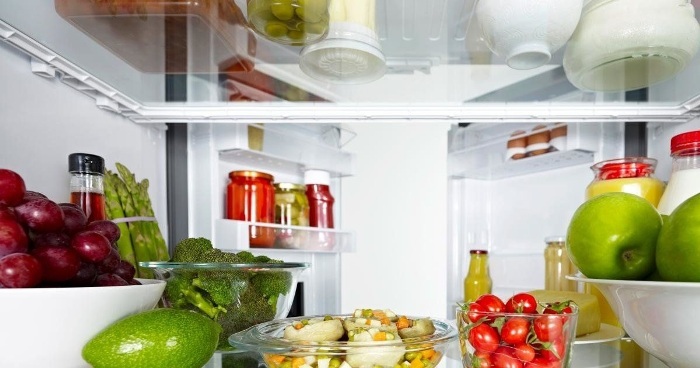
Depending on the price, the zero zone can be cooled in different ways.
In each case, it is possible to artificially maintain a certain level of humidity in the chamber, but this option is used only in expensive models.
What can a freshness zone be called?
Famous manufacturers of refrigerators are constantly introducing new developments into their equipment and improving existing ones. To avoid industrial theft, representatives of most brands patent technology, and the freshness zone in their devices has a unique name:
- Siemens and Bosch - VitaFresh, a hint at the maximum preservation of vitamins;
- Samsung - Chilled Room and Fresh Room, CoolSelect Zone;
- Indesit - FlexCool;
- Electrolux - Natural Fresh;
- LG and AEG - Opti-Fresh Zone;
- Gorenje - Zero’N’Fresh.
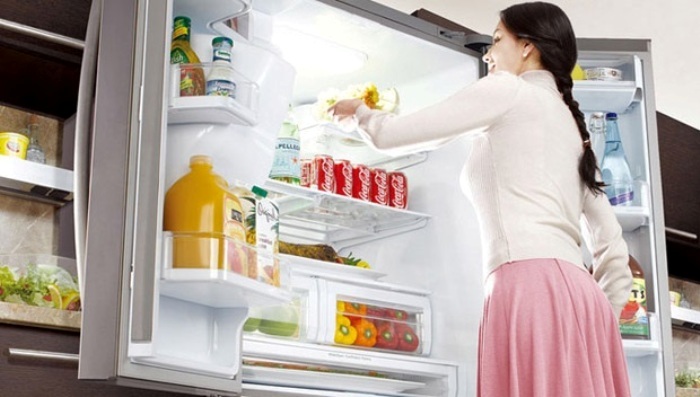
In different brands, the zero zone can be called differently.
The Lipetsk company Stinol, well-known in Russia and the CIS countries, was in the shadow for some time for economic reasons, but in recent years it began to work in close cooperation with the Swedes from Indesit and again entered the market, introducing a series of equipment with a freshness zone and a cooling system Total No Frost
Types of Freshness Areas
For the longest possible storage of different categories of products, not only temperature is important, but also the moisture content in the air. According to this criterion, freshness zones can be divided into two types - dry and wet.
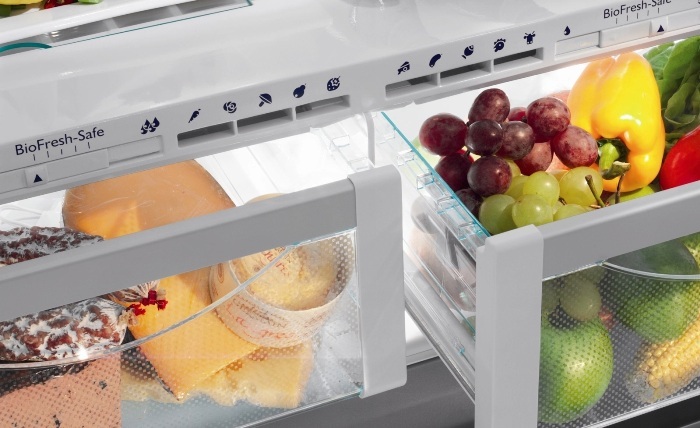
The zero zone can be equipped with one or more doors.
If the refrigerator has only one “zero” compartment, it is dry by default, with a humidity of about 50%. Such a microclimate is suitable for storing all types of meat, fish and seafood - even without packaging, they will retain freshness for about a week. Sausages can be stored even longer, and the presence of preservatives is not a determining factor here. And cheeses, depending on the variety, can be kept in the cell for months without loss of taste.
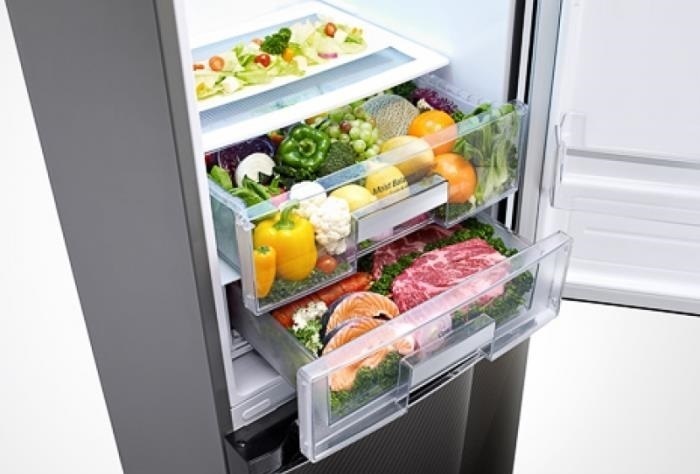
Even without containers in the freshness zone, you can store meat and seafood.
Humidified air (90-95%) in the freshness zone is required for storing berries, fruits, fresh herbs and other products with a high natural water content. In dry conditions, they quickly begin to dry out, lose their attractiveness and taste. A greenish tomato in such a compartment can be safely left for a month - it will not only ripen, but also retain a fresh look. Apples, cucumbers, pears, carrots will persist for several months, and a temperature close to zero will prevent the carrots from germinating.
In many expensive models of refrigerators, both types of zones are present, or manual adjustment of the humidity level is provided. The latter option is less preferable, since it involves the simultaneous storage of only one type of product.

Defrosting in zero zones is carried out in two ways: wet and dry.
Rules for storing food in the freshness zone
Everything that can be stored in the freshness area of the refrigerator, whether it is vegetables or meat, has its own characteristics and microclimate requirements.
- Meat and fish are stored in dry air. If the chamber is with high humidity, then vacuum packaging is needed. Shelf life - a week, for a long period freezing is required.
- Berries, herbs, vegetables and fruits need humidified air, in which plant foods can be stored for months, but only if ethylene-sensitive products (apples, carrots, cucumbers, potatoes) are stored separately from bananas, pears and tomatoes that produce gaseous ethylene. Otherwise, the shelf life of products from the first part of the list will be significantly reduced.
- The shelf life of eggs is increased to 45 days if at the time of placement in the zero zone they were absolutely fresh.
- Sour-milk products are stored tightly packed, cheese needs dry air.
- Bread may not deteriorate within a week if it is packed in a paper bag.
Before storage, parsley, lettuce and green onions should be washed in running water. Then dry with napkins and place in ordinary food containers so that the greens lie in them freely, not squeezed. In this form, even after a month it will retain its appearance without a hint of not yellowness.

To prevent odors of different products from being distributed in the zero zone, it is advised to store them in special containers.
Tips
Any complex technique requires a careful attitude. Before starting operation, it is necessary to study the instructions and carry out regular maintenance according to the recommendations - so the service life of the refrigerator will increase significantly.
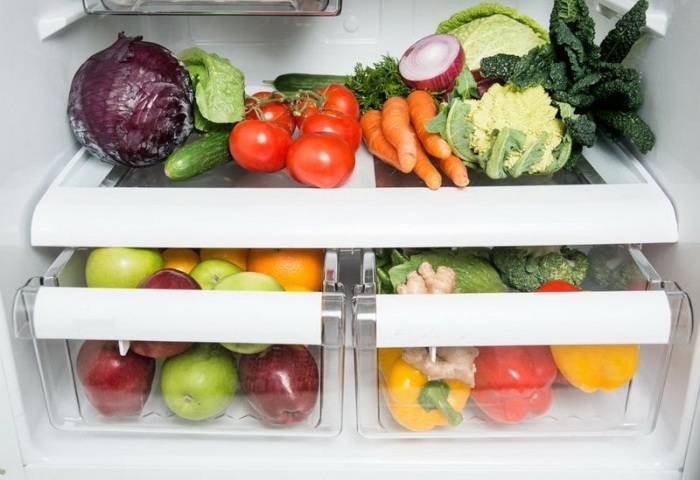
It is advised to clean the zero zone 1-2 times per month.
If an unpleasant odor appears in the freshness zone, and it is not possible to establish the cause, and cleaning does not remove it, it is enough to place a handful of activated carbon in the chamber, the smell will disappear in a day.
If frost or a thin crust of ice is noticed on the products - do not be afraid, this is a feature of the model. Freezing will not go deeper, and will not affect the quality and shelf life.
Freshness Area in Refrigerators


